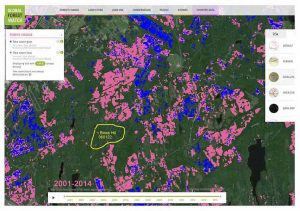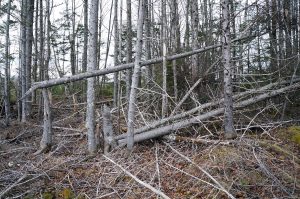Op-eds by two recognized authors of works related to forests and forestry are featured in the CH today:
‘Best management practices’ an insult by Mike Parker; and Spending our forest capital by Gary L Saunders.
Parker’s “Show us the Science” (May The Forest Be With You, Oct 29, 2016) stimulated a lot of back and forth including two rebuttals which he says “were short on substance and did not directly address the challenge to show the people of Nova Scotia the science (peer reviewed or otherwise) behind such questionable forestry practices as rampant clear-cutting, whole-tree harvesting and the biomass debacle that are claimed to be sustainable in perpetuity.” He cites recent soundbites by government such as
As always, these (harvesting) decisions are based on science and best practices.” — Bruce Nunn, DNR spokesman.
“Enough already. Show us the science!” says Parker.
Addressing Parker’s earlier piece, Gary Saunders presents a more nuanced comment than those in the rebuttals cited by Parker (above), most of it not in direct conflict with Parker’s perspectives. “God Forbid” he says, for biomass to make electricity to squander the way we squander paper.” Saunders compliments outspoken wildlife biologist Bob Bancroft: “Yet a few decades of TLC can work wonders. Biologist Bob Bancroft has proved this on the run-down woodlot he’s been coaxing and coddling for 40 years near Antigonish. We can use more of that.” But he makes this curious assertion in defence of clearcutting:
That’s a pretty big generalization. Fear of blowdown seems to drive much of NSDNRs decisions to clearcut. (That fear does not extend, apparently, to the small clumps they leave for wildlife or as seed trees and that are highly susceptible to blowdown.) Likelihood of blowdown (High, Medium or Low) is included in the PTA, so you might expect that selection cuts, or at least some type of partial cuts (although those are often little better than clearcuts) would commonly be prescribed when Likelihood of Blowdown is Low and other conditions indicate a potential to restore an Acadian forest stand. That does not seem to be happening, at least not as often as it could.But why clear-cut? Why not use “selective” cutting, aka the selection method? A few trees here, a few there, spread over decades? But even-aged trees, standing close together, rely on each other for support during hurricanes and heavy snows. So selection cutting soon leads to a tangle of blown timber that’s useless for anything but firewood.
But don’t take my word for it. NSDNR has the stats. As Mike says, Show Us the Science.
Gary Saunders also cites the “half-million or so hectares” of abandoned farmland that has come up in spruce and fir, contending as others have that clearcutting is the only option on those lands. The correct figure is in acres not hectares, I believe, based on the classic paper of Drinkwater. There are areas where yellow birch and other hardwood species that likely occurred on many of those lands before they were cleared for agriculture are beginning to come up… so patience or perhaps seeding of other species into gaps may be other options. I don’t think we have a good answer as to why spruce and fir are so predominant after agriculture, but soil compaction could be a factor, and I wonder about the longer term effects of so much compaction in modern clearcuts of the Acadian forest.


